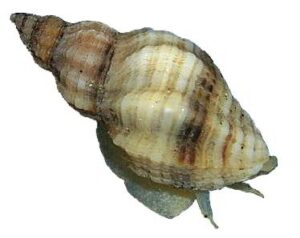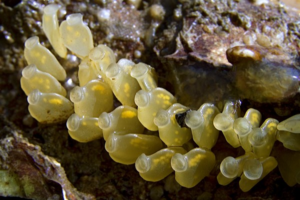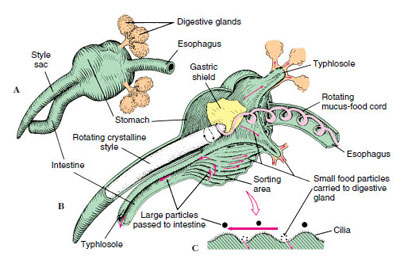
Marine Snails
Snail Menu
Snails
Snail Anatomy
Mud Dog Whelk (Mud Snail)
Moon Snails
Radula
Slipper Shell
Oyster Drill
Murex Snails

American Oyster Drill Urosalpinx cinerea
The Atlantic oyster drill is a species of small predatory sea snail, a marine gastropod mollusk in the family Muricidae, the murexes or rock snails.
 Oyster drills live from low tide down to a depth of 25 feet.
Oyster drills live from low tide down to a depth of 25 feet.
Its surroundings are rocky and shell beds.
They inhabit the lower third of the littoral zone, sheltered from any waves the ocean produces.
 Description
Description
Length 0.5–1 inch.
Color -greyish or yellowish white, often with irregular brown spiral bands
9-12 rounded, axial ribs per whorl and with numerous strong spiral cords.
Siphonal canal moderately short and straight.
Outer lip slightly thickened on the inside and sometimes with 2-6 small, whitish teeth.
Fun Fact – Tyrian Purple is a pigment made from the mucus of one of several species of Murex snail (not the oyster drill) .
<More Details>
Oyster drill radula or tooth ribbon allows them to drill into oysters, mussels and barnacles.
They penetrate shells in about 45 minutes.
After drilling the hole, they insert a tube called proboscis to deliver the digestive enzymes that disintegrate the tissue of their prey.
They usually hunt in groups or packs.
Researchers have found that the oyster drills actually “smell” their food.
Oysters and other shelled animals on the oyster drills’ menus have a certain body odor.
This body odor is made up of little bits of chemicals. When the drills smell one of these chemicals, they follow the scent to their next meal.
Physical Description
Urosalpinx cinerea is about 3/4 to one inch long and 0.6 inch wide.
Its flesh is of a gray or yellowish color with brown spiral stripes.
Its shell has a rough texture created by an average of 12 ridges running longitudinal along the shell.
The shell is also characterized by 5 to 6 raised whorls.
The lip of the shell typically has between 2 and 6 teeth and is scalloped along with a short aperture with a canal.
Young members of the species seem to only differ from adults in relative size including length and mass.
Food Habits
Food usually consists of oysters, mussels, barnacles and other sessile mollusks. This makes the oyster drill a carnivore.
It prefers to prey upon smaller softer shelled oysters, which are much easier to penetrate and eat. They are usually stationary or somewhat mobile feeders that remain in set stationary breeding or living beds located on the floor of the shoreline.
 Urosalpinx cinerea crawls over the beds finding small oysters. It then grips the shell with its foot, which secretes an acidic softening agent and uses its radula, (drill) in a mechanical process to break through the prey’s shell.
Urosalpinx cinerea crawls over the beds finding small oysters. It then grips the shell with its foot, which secretes an acidic softening agent and uses its radula, (drill) in a mechanical process to break through the prey’s shell.
Once this occurs the oyster drill inserts its proboscis into the victim, which then secretes a muscle relaxer into the prey causing the oyster to open exposing the animal inside.
After drilled, a total of one fourth of the oyster’s tissue remains inside. This tissue consists of the adductor muscle, various soft parts, and the gills.
The muscle destruction of the oysters caused by the drill was found to range from none to total destruction. However, it was found that in 90% of the oysters studied, at least half of the adductor muscle was destroyed.
The oyster drill exhibits a clear preference when eating consisting of various soft tissues, the gills, and the adductor muscle allowing it to eat as long as possible on one oyster before it gapes allowing other predators to feed upon it.
Urosalpinx cinerea drills the oysters through the central portion of the valve and not at the margin of the valves.
Reproduction
Ocinebrellus inornatus is gonochoristic, having separate sexes and eggs are fertilized
internally.
Spawning occurs throughout the summer.
Atlantic oyster drills lay distinctive leathery, vase-shaped eggs that attach to a hard surface. Larvae crawl from the eggs within six to eight weeks.
 The hatching embryo produces an enzyme that dissolves the protective sack. The average time it takes for an embryo to develop from fertilization to hatching is 40 days.
The hatching embryo produces an enzyme that dissolves the protective sack. The average time it takes for an embryo to develop from fertilization to hatching is 40 days.
The embryonic development itself is related to that of other gastropods and the young snail emerges as a well-formed snail.
Economic Importance for Humans: Negative
Urosalpinx cinerea is a natural predator for Eastern Oysters as well as other mollusks. It especially prefers soft-shelled young oysters and tends to eat numerous small meals instead of one larger one. Therefore, the species can become a real pest in commercial oyster areas killing off large numbers of young oysters reducing the amount of harvestable oysters in the succeeding years.
